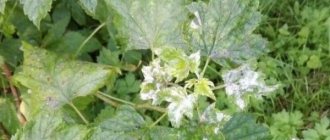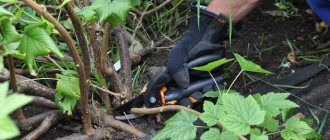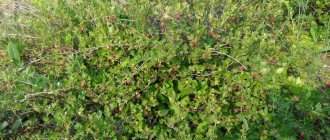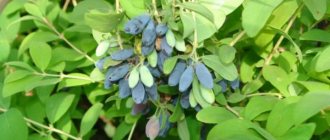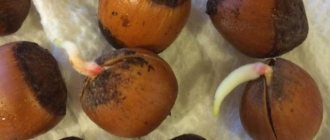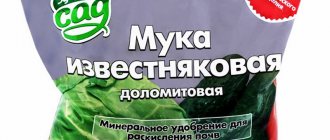Description of the pest
The kidney mite is a small pest, similar to a light worm, the size of which does not exceed 0.2 mm. Most often, the parasite damages black currants, but can be found on red and white currants, as well as gooseberries. Pests settle in the kidneys, reproduce there, develop, and overwinter. One kidney can contain from 3 to 5 thousand individuals. During the season, 5 generations of parasites appear.
Ticks are spread by infected planting material, insects, birds, and wind. If you do not take action after the bud mite has settled on the currant, you can completely lose the bush in one season.
Infected kidney
Causes of the pest
The main reason for the appearance of the pest is the planting of infected seedlings on the site . Thousands of ticks are carried by the wind, birds, and spread through gardening tools and human clothing .
The pest is sensitive to weather conditions; in dry and hot weather it actively reproduces on currants.
First of all, it attacks weak plants that lack nutrients and moisture. In dense plantings, currants lag behind in growth and yield. Such shrubs are often affected by viruses and attract pests.
Signs of insect pest damage
Since the currant mite lives on the affected plant all year round, signs of infection can be detected at almost any time of the year.
In spring and summer
The easiest way to detect bushes infected with currant bud mite is in early spring, when the branches have not yet covered with leaves. Infected kidneys are much larger in size than healthy ones. She looks like a large pea.
In summer, these signs are added to the following:
- young leaves grow irregularly shaped and curl;
- the leaves acquire a lighter shade, their surface becomes coarser;
- the affected buds dry out;
- bunches of thin reddish shoots, similar to panicles, appear on the branches;
- leaves become covered with red spots;
- bush growth slows down.
On red currants, mite damage remains unnoticeable for a long time, which complicates the timely initiation of treatment.
in autumn
In autumn, the main signs of mites on currants are the same buds. Unlike healthy ones, their surface is not smooth and elastic, but loose and soft. The affected kidney looks like a tiny, tousled head of cabbage. This is explained by the large number of parasites gathered for the winter.
Signs of a pest and damage caused
Healthy flower buds of currants are rounded and elongated, leaf buds are simply elongated, their scales are dense. Buds with mites differ from normal ones, which can be seen visually. By autumn they enlarge, swell, become large and round. In the spring of next year, they increase to the size of a pea, and the scales diverge and the embryos of the leaves appear through them. This gives the buds the appearance of a burst cabbage head.
In spring and summer, the shape, color and size of young leaves on the tops of the shoots change. They become rough, deformed, look lighter in color than the rest, and the affected green shoots slow down their growth.
The harm of currant bud mites is that the pests suck the juice from the tissues, the growth of leaf and flower buds is disrupted, they do not develop normally, some may not even bloom. Affected bushes produce little new growth, are less leafy, their fruits become smaller, ripen unevenly, and become sour. Yield losses can be about 20%. Among other things, mites transmit pathogens that cause leaf reversal and double bloom of blackcurrant flowers.
The danger of currant bud mite
The appearance of bud mites negatively affects the condition of the bush:
- some of the affected buds do not bloom, but gradually dry out, which causes a decrease in yield;
- since mites feed on the juices of the plant, it develops worse and weakens;
- witches' panicles that appear on the affected bushes do not bloom or bear fruit, but take a lot of nutrients, depleting the plant;
- parasites carry a dangerous disease - terry, which cannot be cured.
Pests spread quite quickly throughout the area, affecting all existing currant and gooseberry bushes.
Danger of defeat
It must be said that the bud mite harms not only currants, but also gooseberries and even raspberries, so when this insect appears, control measures must be serious. The pest attacks currant buds, which become deformed, become more massive, and plump in appearance. Then initially damaged, weak shoots grow from these buds: as you understand, you cannot expect good harvests from such young growth.
In addition to the danger of crop loss, the bud mite also carries dangerous diseases, including mosaic and leaf blight. But how susceptible the Pygmy blackcurrant variety is to pests is indicated here.
The video describes the problem:
Keep in mind that to combat the bud mite, it is best to use timely preventive measures, simply by not allowing the pest to reach the bushes. If the insect has already seriously affected the currant, the bush cannot be treated: it must be uprooted and urgently destroyed.
Symptoms of the lesion
You can recognize the bud mite on currants in the spring, when the buds of the plant begin to swell. This is the time when the harmful insect begins to become active. If a healthy bud is a smooth process of a regular elongated shape, then the one affected by the mite looks like a short, plump and loose head of cabbage. The diameter of such a bud is about 1 cm.
It must be said that tick larvae, once in a favorable environment, begin to multiply at a very rapid pace. And in a short period of time, the pest is able to capture almost all the buds on the bush. But how to deal with powdery mildew on currants, and what can be done with this problem with home remedies, is indicated here.
Measures to combat kidney mites
The fight against bud mite on currants requires a special approach. The thing is that until the time of flowering, the parasites are protected by tightly closed buds. And the use of effective chemicals during the flowering period, when mites become vulnerable, can lead to the death of beneficial pollinating insects, as well as damage to the crop. Therefore, it is necessary to combine mechanical, agrotechnical and traditional methods.
Removed kidneys
Removing buds and shoots
Removing affected buds is one of the most effective options, helping both to get rid of the bud mite and to preserve a healthy part of the plant. But this method only works at the initial stage of infection, when there are very few swollen buds. If there are a lot of swollen buds, the branch must be cut off completely. In case of large-scale infection of the bush, all branches are cut off at the root. In this case, there is a high probability that new shoots will appear in the spring, and after 2-3 years the bush will recover and begin to bear fruit.
Bush processing
Spraying bushes is another effective way to combat bud mites. Depending on the degree of damage, currants are treated with biological and chemical preparations, as well as decoctions and infusions prepared according to folk recipes. Most often, treatment is carried out in the fall, after harvesting.
Chemicals
One of the most popular measures to combat bud mites on currants in spring and autumn is spraying with special chemicals. You can use acaricidal or insectoacaricidal agents, but insecticides will not have any effect on ticks. The procedure is carried out three times:
- in early spring to destroy overwintered parasites;
- after 10 - 12 days, to destroy the offspring hatched from the laid eggs;
- after another 7 - 10 days to increase the effectiveness of previous treatments.
This method requires compliance with safety precautions - you must follow the dosage, wear protective clothing, a mask, and gloves.
Organophosphorus compounds
When deciding how to treat currants against mites in the fall, many gardeners choose organophosphorus preparations. They quickly and effectively destroy parasites, but given the high toxicity, application should be postponed until the crop is fully harvested. Otherwise, the berries will not be eaten.
Biological drugs
There are biological preparations that effectively help fight bud mite on currants. Most of these products are created on the basis of positive strains of bacteria and fungi, do not pose a danger to humans, and do not harm crops.
Attention! There is one important nuance - currants should be treated with biological preparations only at air temperatures above +15... +20⁰С. At lower temperatures the products are ineffective.
Biological products are actively used in the spring, combined with biofungicides for better results.
Folk remedies
One of the most effective and used methods of controlling ticks in the fall is dousing the bushes with hot water. The water must be brought almost to a boil, poured into a watering can and watered over the infected bushes. The optimal water temperature is +80⁰С. Such a procedure will not harm healthy kidneys, but it will be destructive for ticks. For one medium-sized bush, 5-6 liters of water are enough.
Boiling water treatment
The following infusions are also used to process currants:
- garlic (200 g of crushed product per bucket of water, leave for 3 hours);
- mustard (200 g mustard powder per 10 liters of water, leave for 8 hours);
- dandelion (250 g of crushed leaves and roots per 10 liters of water, leave for 2 hours, stirring occasionally);
- onion peel (300 g per 10 liters of water, leave for 2 days);
- tobacco;
- wormwood.
Infusions are filtered before use. You can also use a soap solution to process currants.
Growing resistant currant varieties
During breeding work, many varieties were developed that were resistant to bud mite damage. Among them:
- Vigorous;
- Selechenskaya;
- Nara;
- Summer resident;
- Black Pearl;
- Kipiana.
Choosing specific varieties does not provide a 100% guarantee of protection against pests, but the risk of mites is noticeably reduced.
Blackcurrant resistant to bud mite
To reduce the likelihood of mite infestation of shrubs, varieties resistant to it should be planted. Unfortunately, there are no completely resistant ones yet, but some are less affected than others.
The following varieties of black currant can be planted in the garden plot: Black Pearl, Otradnaya, Irmen, Nightingale Night, Riddle, Memory of Michurin, Belarusian Sweet, Chernysh, Vigorous, Nara, etc.
Varieties of red currant: Scarlet Dawn, Red Cross, Ilyinka, Beloved, Chulkovskaya, Ogni Ural, etc.
Varieties of white currants that are more resistant to mites: White Fairy, Belka, Snezhana, Bayana, etc. When choosing a variety, you need to consider whether it is zoned or not relative to your area.
Prevention of tick-borne infestation
The following preventive measures will help to avoid infection with kidney mites or minimize damage:
- sanitary treatment of seedlings before planting is necessary;
- cuttings for propagation can only be taken from healthy plants;
- bushes should be located at a sufficient distance from each other to avoid branches touching;
- After processing each bush, garden tools must be disinfected before moving on to the next bush;
- regularly inspect currants for infected buds;
- carry out preventative pruning in spring and autumn;
- destroy pruned shoots, fallen leaves, weeds, old mulch;
- plant tick-repellent onions or garlic next to the bushes.
Bow defense
In addition, to prevent the appearance of parasites, you can treat the bushes with special biological and chemical agents.
How to fight parasites?
With minor damage, in the initial stages it is possible to cope with ticks using folk remedies, physical and agrotechnical methods. Mass resettlement is dealt with by resorting to biological and chemical pesticides.
Agrotechnical methods
These are auxiliary methods of combating parasites, allowing to reduce their numbers.
Spider mite
- destruction of weeds;
- annual thinning of bushes;
- timely watering of currants in dry weather;
- collection and burning of damaged leaves and leaf litter:
- autumn digging of tree trunk circles.
Kidney mite
- early spring cutting of branches with numerous swollen buds.
Physical methods
You can get rid of spider mites by repeatedly watering the bushes with a stream of cold water from a hose. The parasites are washed onto the ground, where they die, mixing with the damp soil. Dampness is not very comfortable for pests; it suppresses their vital activity.
See also: How can you feed blackcurrants for a better harvest?
Swollen buds infected with mites must be collected early in the spring and immediately burned.
Use of specialized tools
In the spring, while the weather is cool, treating bushes with pesticides based on malathion (karbofos): Antiklesch, Fufanon-Nova, Iskra M, Alatar, Inta-Ts-M will be effective. Spraying is done when the buds swell, immediately before flowering and immediately after it. If the number of pests is large, the event is repeated after harvest and in the fall, before the leaves fall.
Sulfur-based preparations
If malathion has a minimum waiting period of 3 weeks, then sulfur-based pesticides have only 1 day.
Bushes are treated with sulfur preparations:
- from bud mite - before and after flowering;
- from spider mites - when the pest appears.
Colloidal sulfur is mixed in water at the rate of 50-75 g per 5 liters of water. Fungicide Tiovit Jet is diluted according to the instructions for the drug.
IMPORTANT! Sulfur negatively affects parasites through evaporation, which occurs at air temperatures from +18 to +28 degrees.
Biological products
In warm weather (20 degrees and above), it is better to treat currants against any mites with biological pesticides (waiting period 3 days):
- Fitoverm;
- Spark Bio;
- Kleschevitis;
- Tickman.
Bitoxibacillin is also effective against spider mites (waiting period 5 days).
Folk remedies
Affordable and environmentally friendly methods of controlling ticks are based on the phytoncidal effects of some plants:
- Garlic infusion: 80 g of crushed heads are poured with three liters of hot water and kept for two days.
- Onion peel infusion: 130 g per 3 liters of boiling water.
Bushes on which swollen buds are found are irrigated at the very beginning of the growing season, then before and after flowering. Spider mites are destroyed as they appear.
Control measures
It is difficult to catch this secretive insect, but it is possible. First of all, before the leaves bloom, carefully examine the branches of the bush and, if you see buds on them, immediately remove them and burn them. If there are a lot of such buds, cut off the shoot completely.
It is better to remove severely affected shoots completely. In the future, you will need to spray the currants with a suitable preparation. The main emphasis should be placed on the moment of the first migration of ticks from one bud to another, which coincides with the period of budding of the bush. It is important not to miss this particular relocation of the pest, which will prevent its further spread.
Chemicals
During the bud protrusion phase, treat the berry plant with a solution of a low-toxic non-systemic acaricide or insectoacaricide, for example, Envidor, Kontos, Nissoran, Oberon, or the like. Since the migration of mites lasts up to 4 weeks, repeat the treatment with one of these preparations immediately after the end of flowering, and again after 10-12 days to consolidate the effect. It is not worth using more toxic products (“Famidophos”, “Dimetrin”, “Accent”, “Danadim”, etc.) during this period; systemic acaricides can be used after harvesting.
The first spraying is carried out in the budding phase. Colloidal sulfur has proven itself well in the fight against this pest. Treatment before flowering is carried out with a solution of 10 liters of water and 10 g of powder; during the next spraying, the dose of colloidal sulfur is halved. However, you won’t be able to fight this enemy on gooseberries using such a chemical: it causes burns on the leaves.
Number of spring treatments and their timing
To ensure that treatment against ticks does not become a “blank shot”, it is necessary to take into account the development cycle of these insects, which is closely linked to air temperature. In spring, the larvae of kidney mites show their first activity when the temperature ranges from 10 to 13 degrees Celsius.
However, their exit from the buds and movement to other currant bushes usually occurs after 3 weeks, at a temperature of +18 degrees.
In accordance with the development cycle of the parasite, it is necessary to plan the timing of treatments. There should be three of them during the spring-summer time.
First treatment against kidney mites
It is aimed at exterminating successfully overwintered females and newly emerged larvae. This treatment should be done a few days before flowering.
Second treatment
As soon as warm weather sets in, the development cycle of the second generation of larvae is completed. At this point, the currant bushes should be sprayed with insecticide again. If you are late with this procedure, the larvae will have time to become adult insects and lay eggs. The second treatment is carried out approximately 8-10 days after the first.
Third treatment for kidney mites
The third spraying is safety. Its goal is to exterminate the surviving young females so that they do not have time to lay eggs. This treatment begins 9 days after the second spraying.
Biological drugs
Adherents of eco-farming who do not accept chemistry can use biological acaricidal preparations to spray currants, for example “Fitoverm”, “Akarin”, “Vertimek”, “Bikol”, “Bitoxibacillin”, etc. Use bioacaricides at the same time, preparing the solution according to the instructions for the selected drug. But in this case, remember that such protective equipment will be effective only at a certain air temperature, so carefully read the characteristics of each of them.
Recommended Biological Products
How to treat currants against mites in spring? These drugs include bioacaricides, developed on the basis of bacteria and fungi that are not dangerous to the human body. Despite the positive aspects of the drugs and their effectiveness, the use of bioinsectoacaricides and bioacaricides has a number of limitations. The best results can be achieved when using the products at temperatures above 15 degrees; use in cold and windy weather is useless. Bioacaride preparations include:
- Akarin;
- Phytofarm;
- Bitoxibacillin;
- Boverin;
- Bicol
How to get rid of mites on currants? The use of products occurs depending on the temperature, at intervals, until the end of flowering, immediately after harvesting. It is necessary to alternate medications that combine well with sbiofungicides. When using new drugs, it is necessary to check their compatibility; the dosage and dilution method can be read on the packaging. To achieve maximum effect and avoid plant death, you must strictly follow the instructions.
Use a gas burner
Another effective method is fire treatment. You need to point the gas burner at the bush, keeping a distance of 10 cm from the branches. Movements should be fast so as not to burn the bush, and directed from top to bottom.
Healthy buds have dense scales that protect them from fire. Buds affected by pests, on the contrary, are open and porous, so the heat will penetrate inside and destroy the bud mite along with the larvae.
What do currant buds look like when they are infected with a mite?
The easiest time to identify the pest is in the fall. Then the affected buds swell and are noticeably different from the rest.
In the autumn period, immediately after leaf fall, two types of buds can be distinguished:
- Healthy buds are round, slightly elongated. They do not lag behind in development and are covered with dense scales.
- Sick, deformed, round kidneys that are swollen from a large number of parasites. This is where the pests spend the winter.
In spring and summer, affected buds can be distinguished by the following characteristics:
- the tops of young shoots become deformed and change color;
- the leaf blade becomes stiffer, acquires a light green or yellow color, while the leaves become smaller due to depletion;
- young shoots stop growing;
- the berries do not ripen - they remain small and sour;
- freezing of shoot growth.
The currant bush is affected by viruses that are carried by mites (witch's broom, leaf reversion, flower doubleness). In this case, the plant must be urgently pruned and burned, since there is no treatment for such diseases.
Characteristics of an insect
The kidney mite settles in colonies, its population gradually increases and begins to fill the kidney. The result is the stopping of leaves and shoots in development, infection of the buds, which become sources of viral infections.
Description of appearance
Cecidophyopsis ribis is a very small worm, the body of which is no more than 0.04 mm wide and 0.15 mm long.
The pest settles in the buds of berry bushes, where it goes through all stages of its development. Females lay small oval-shaped eggs, usually in the month of March. These eggs are transparent, but then become white or milky. The parasite leaves the bud house after the currants throw out leaves and flowers.
Since the tick is very small, it is almost impossible to see it with the naked eye. The main way to detect a pest is the appearance of corresponding symptoms.
Life cycle
Ticks hatch from eggs that females lay in early spring. The tick does not leave the bud - its main hiding place - until leaves appear on the bushes. Then the pests move on to the leaves and bark, where 99% of the entire population dies. Surviving ticks move to another permanent place of residence closer to June and lay eggs. Five generations can develop in one bud; at a time, the mite lays a hundred eggs or a little less. If nothing is done, the pest will first destroy the crops, then the currant bushes as a whole and move to neighboring plants. Find out about planting and caring for Aflaut onions here.
In Latin, the name for all varieties of currants is ribes. The Spaniards gave it to the plant even before our era.
What are these round buds on currants, what to do
The kidney mite is a tiny arthropod that is very difficult to see with the naked eye. The size of adult females barely reaches 0.2 mm, and males are even smaller. This pest prefers to settle in the buds of the plant. Most often found on black currants, less often on red and white varieties.
The body of the kidney mite is whitish in color and elongated in shape. In the front part there is an oral apparatus in the form of a wedge-shaped trunk. The pest has two pairs of legs, which are covered with feathery bristles. In the larval stage, the bud mite has an oval-round body shape and a light color.
Life cycle of currant bud mite
Female pests overwinter directly in the buds of the plant. In the spring, with the arrival of warmth, they begin their activity and lay eggs. After 6-12 days, new offspring appear. The voracious larvae suck the juice from the bud, and when the food runs out, they move to a new one.
By the time foliage actively grows, two generations of mites have already appeared. And since each female is capable of laying up to 800 eggs at a time, they become crowded in one kidney. The resettlement occurs during the period of budding and flowering of currants and lasts a whole month. At this time, due to the large accumulation of ticks and their emergence, they can be seen with the naked eye. Subsequently, before the currant berries ripen, three more generations of the pest appear.
Important! The life cycle of the female is 20-45 days, and the stay of the offspring in the larval stage is 10-30 days.
Damage caused by the bud mite to currants
The bud mite belongs to the category of dangerous pests of currants, since in the presence of favorable development conditions up to 40 thousand individuals can appear during the season. And their peculiarity of settling in closed buds significantly complicates the process of struggle.
Mite-infested buds resemble a stuffed head of cabbage
The bud mite on its paws carries diseases such as leaf curl and flower terry. Due to complex damage, currant immunity is sharply reduced. As a result, young shoots weakly form on the infected bush, foliage growth slows down, buds and ovaries fall off, and the bush begins to wither.
Important! The adaptability of the bud mite to any disaster is so reliable that if adequate measures are not taken at the first signs of damage, the currant bush may die during the season.
Causes and signs of damage
The kidney mite is easily carried by the wind, as well as on animal fur and human clothing. Therefore, if one currant bush is damaged, the likelihood of spreading to the entire plantation increases significantly. In addition, this pest is dangerous for raspberries and gooseberries, which may grow nearby.
The main reason for the mass reproduction of the bud mite is the low immunity of plants, which is not able to withstand its effects. This can be caused by the following factors:
- drought and heat, which contributes to the rapid proliferation of the pest;
- lack of nutrition that weakens plants;
- infection with viruses and fungal diseases;
- excessive dustiness of foliage, disrupting biological processes in tissues.
The easiest way to identify bud mites on black currants, as seen in the photo above, is in early spring or late autumn after leaf fall. During this period, the affected kidneys swell significantly and clearly stand out against the background of healthy ones. The latter are well developed, their shape is rounded and elongated, they are tightly covered with superficial scales. Tick buds on currants show obvious signs of deformation, become round and swell due to the large number of overwintering pests inside.
Damage can be determined in the summer by the following signs:
- apical young shoots become lighter, their growth is slowed down;
- leaf size decreases;
- young growth becomes tough;
- the berries become smaller and become sour;
- bush growth stops.
You need to start fighting the bud mite on black, red and white currants as soon as the first symptoms appear, since it is very difficult to remove the pest in case of massive infestation.
Danger and harm
These mites are considered very dangerous pests that are capable of destroying garden and berry crops in one season. One female gives 5 generations annually, two in the spring and three in the summer-autumn. This is a huge number of individuals, the number of which ranges from 15 to 40 thousand per year. They adapt very easily to new conditions and easily tolerate different climatic conditions.
Considering that they almost always have protection, since they live in buds, galls, and shoots, they are less exposed to external influences. In addition, such protection significantly complicates the procedure for combating them. If you do not take effective measures to combat them, then in one season they can destroy infected bushes.
Prevention measures
To avoid the massive spread of bud mites in currant plantings, you need to follow simple rules. This will significantly reduce the likelihood of injury.
Basic preventive measures:
- purchase seedlings from trusted sellers;
- do not take cuttings from infected plants;
- after sanitary pruning, burn all shoots and disinfect the tools;
- carefully inspect all seedlings before purchasing;
- carry out preventive treatments annually in early spring and late autumn;
- Irrigate the bushes with water using the sprinkling method during hot, dry periods.
How dangerous are bud mites for plants?
The currant bud mite is a representative of the group of four-legged mites. All of them are smaller than 0.5 mm, and the currant one, even more so, is only 0.2 mm in length. Most four-legged ticks are very sensitive to low air humidity and high temperatures. Therefore, they live in the buds of plants and inside various formations of shoots (witches' brooms) or leaves (galls and felts), which are formed due to the activity of these parasites.
At the moment of flowering of the currant, the affected buds begin to wither, and the female mites climb to the surface. This is the only moment in their life when they are not protected by bud scales. Having left the bud, the pests look for young shoots and buds in the axils of the leaves, penetrate them and begin to feed and reproduce. At least three generations of parasites are born before autumn. The damaged kidney increases in size, swells and takes on a rounded shape. It will no longer be able to produce either full-fledged shoots or leaves.
Moreover, this type of mite actively carries various diseases that weaken currants, including the notorious mycoplasma, which causes double currant flowers. Bushes oppressed and weakened by mites are actively affected by stem pests: small species of longhorned beetles, borers, glass beetles.
In winter, the pest waits out the cold under the protection of bud scales. In the spring, at the first warming, ticks begin feeding and reproducing again. By the time the currants bloom, they have time to produce two more spring generations. The time of budding and flowering of currants is coming. The affected buds begin to die, the hungry parasites again leave their cozy shelter in search of young shoots and new tasty juicy buds. They can travel through the affected bush in the thousands. They are carried from plant to plant by the wind, insects, birds, as well as people on their hands, tools and clothes. The more mites on the currant, the more buds will not wake up next spring.
How does the currant bud mite develop?
Fertilized females wait out the winter in their buds, which allows them to protect themselves from frost and other adverse weather conditions.
Spider mites on currants begin to actively lay eggs when temperatures reach 5 degrees Celsius. A female can lay 7-8 thousand eggs at a time, one kidney can accommodate 4-7 thousand individuals, which causes it to swell to a round size. The development of the larva inside the egg continues for up to two weeks; after the bud breaks during the flowering period, the parasites begin to feed.
The mite on black currant sucks out all the juice of young shoots, which leads to the death of the plant that has not yet blossomed. Larvae and females migrate within 30 days, this period usually occurs when the plant is flowering.
The problem will be visible to the naked eye. Relocation of pests to other shrubs occurs with the help of rain, clothing and wind; control methods are selected depending on the flowering period.
The currant bud mite is one of the harmful parasites for garden and berry crops. A female can reproduce up to five generations in one year, which is equal to about 30,000 individuals. Over time, they adapt to bad weather conditions, which makes them more resilient. If preventive measures are not taken in advance, the bush dies in one season.
Most often, the bud mite infects the bud of a currant bush. In terms of external signs, the affected kidneys differ from healthy ones by visible deformation; they enlarge and take on the shape of a pea. In autumn you can notice two types of buds on the currant bush:
- Patients look like a small head of cabbage, the kidneys are enlarged and round. A large number of female ticks causes the buds to swell to enormous sizes; with the onset of warm weather, they multiply.
- Healthy buds have an oblong, round shape with closed scales.
You may also notice the following changes:
- The bud stops developing, the stems become disheveled, which indicates a viral infection of the bush, which could have been infected by a parasite. In this case, the plant cannot be treated, it soon dies.
- The surface of the leaf blade becomes rough, deformation is observed, and the color becomes pale.
- The upper young shoots change their color, brightness and size.
Such signs are observed in the spring and summer.
